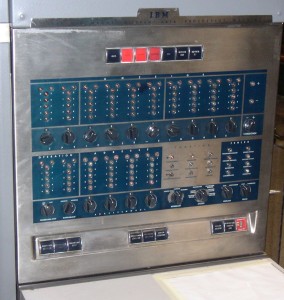Logic programming is a programming, database and knowledge-representation and reasoning paradigm which is based on formal logic. A program, database or knowledge base in a logic programming language is a set of sentences in logical form, expressing facts and rules about some problem domain. Major logic programming language families include Prolog, Answer Set Programming (ASP) and Datalog. In all of these languages, rules are written in the form of clauses:

In computer programming, a macro is a rule or pattern that specifies how a certain input should be mapped to a replacement output. Applying a macro to an input is known as macro expansion. The input and output may be a sequence of lexical tokens or characters, or a syntax tree. Character macros are supported in software applications to make it easy to invoke common command sequences. Token and tree macros are supported in some programming languages to enable code reuse or to extend the language, sometimes for domain-specific languages.
Prolog is a logic programming language that has its origins in artificial intelligence and computational linguistics.
In computing, serialization is the process of translating a data structure or object state into a format that can be stored or transmitted and reconstructed later. When the resulting series of bits is reread according to the serialization format, it can be used to create a semantically identical clone of the original object. For many complex objects, such as those that make extensive use of references, this process is not straightforward. Serialization of object-oriented objects does not include any of their associated methods with which they were previously linked.
In computer science, an abstract machine is a theoretical model that allows for a detailed and precise analysis of how a computer system functions. It is similar to a mathematical function in that it receives inputs and produces outputs based on predefined rules. Abstract machines vary from literal machines in that they are expected to perform correctly and independently of hardware. Abstract machines are "machines" because they allow step-by-step execution of programmes; they are "abstract" because they ignore many aspects of actual (hardware) machines. A typical abstract machine consists of a definition in terms of input, output, and the set of allowable operations used to turn the former into the latter. They can be used for purely theoretical reasons as well as models for real-world computer systems. In the theory of computation, abstract machines are often used in thought experiments regarding computability or to analyse the complexity of algorithms. This use of abstract machines is fundamental to the field of computational complexity theory, such as finite state machines, Mealy machines, push-down automata, and Turing machines.
David H. D. Warren is a computer scientist who worked primarily on logic programming and in particular the programming language Prolog in the 1970s and 1980s. Warren wrote the first compiler for Prolog, and the Warren Abstract Machine execution environment for Prolog is named after him.
SWI-Prolog is a free implementation of the programming language Prolog, commonly used for teaching and semantic web applications. It has a rich set of features, libraries for constraint logic programming, multithreading, unit testing, GUI, interfacing to Java, ODBC and others, literate programming, a web server, SGML, RDF, RDFS, developer tools, and extensive documentation.
Constraint Handling Rules (CHR) is a declarative, rule-based programming language, introduced in 1991 by Thom Frühwirth at the time with European Computer-Industry Research Centre (ECRC) in Munich, Germany. Originally intended for constraint programming, CHR finds applications in grammar induction, type systems, abductive reasoning, multi-agent systems, natural language processing, compilation, scheduling, spatial-temporal reasoning, testing, and verification.
In computer science, an abstract state machine (ASM) is a state machine operating on states that are arbitrary data structures.
In computer science, a term index is a data structure to facilitate fast lookup of terms and clauses in a logic program, deductive database, or automated theorem prover.

Programming language theory (PLT) is a branch of computer science that deals with the design, implementation, analysis, characterization, and classification of formal languages known as programming languages. Programming language theory is closely related to other fields including mathematics, software engineering, and linguistics. There are a number of academic conferences and journals in the area.
In computer science, the well-founded semantics is a three-valued semantics for logic programming, which gives a precise meaning to general logic programs.
XSB is the name of a dialect of the Prolog programming language and its implementation developed at Stony Brook University in collaboration with the Katholieke Universiteit Leuven, the New University of Lisbon, Uppsala University and software vendor XSB, Inc.
YAP is an open-source, high-performance implementation of the Prolog programming language developed at LIACC/Universidade do Porto and at COPPE Sistemas/UFRJ. Its Prolog engine is based in the WAM, with several optimizations for better performance. YAP follows the Edinburgh tradition, and is largely compatible with the ISO-Prolog standard and with Quintus Prolog and SICStus Prolog. YAP has been developed since 1985. The original version was written in assembly, C and Prolog, and achieved high performance on m68k-based machines.
The following Comparison of Prolog implementations provides a reference for the relative feature sets and performance of different implementations of the Prolog computer programming language. A comprehensive discussion of the most significant Prolog systems is presented in an article published in the 50-years of Prolog anniversary issue of the journal Theory and Practice of Logic Programming (TPLP)..

Cuthbert Corwin Hurd was an American computer scientist and entrepreneur, who was instrumental in helping the International Business Machines Corporation develop its first general-purpose computers.
Modula-2 is a structured, procedural programming language developed between 1977 and 1985/8 by Niklaus Wirth at ETH Zurich. It was created as the language for the operating system and application software of the Lilith personal workstation. It was later used for programming outside the context of the Lilith.
Tabling is a technique first developed for natural language processing, where it was called Earley parsing. It consists of storing in a table partial successful analyses that might come in handy for future reuse.



